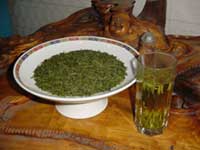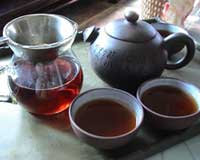China is the homeland of Chinese tea. Tea from China, along with silk and porcelain, became known to the world over a thousand years ago and is today one of China’s most valuable exports. The Japanese adopted the habit of drinking tea in the 6th century, but it was not introduced to Europe and America until the 17th and 18th centuries.
According to legend, in 2737 BC, the Chinese emperor Shen Nung was sitting beneath a tree, while his servant boiled drinking water, when some leaves from the tree blew into the water. It is impossible to know whether there is any truth in this story, but drinking tea has been a part of Chinese culture for many centuries. In 800 A.D. a writer named Lu Yu, known as the tea sage, wrote the Tea Classic. It was shortly after this that tea was first introduced to Japan by Japanese Buddhist monks who had traveled to China to study.
People throughout China drink tea daily because of its healthful properties. Various kinds of tea are grown in the vastly differing geographic locations and climatesof China. Chinese teas generally fit into five classifications.
 Green Tea
Green Tea
Green tea is a very lightly fermented (dried) tea that keeps its original color during processing. This category consists mainly of Longjing tea of Zhejiang Province, Maofeng of Huangshan Mountain in Anhui Province and Biluochun produced in Jiangsu.
Note: The term fermentation when applied to tea is something of a misnomer, as the term actually refers to how much a tea is allowed to dry. The drying may be stopped byeither pan frying, baking or steaming the leaves before they are completely dried.
Black Tea
Black tea, known as red tea (Hong Cha) in China, is fermented before baking. It is a later variety developed from green tea. The best brands of black tea are Qihong of Anhui, Dianhong of Yunnan Suhong of Jiangsu, Chuanhong of Sichuan and Huhong of Hunan
Wulong Tea
This is a variety between the green and black teas, and is partially fermented. It is a specialty from the provinces on China's southeast coast, Fujian Guangdong and Taiwan.
 Compressed Tea
Compressed Tea
This tea is compressed and hardenedintoshapes, usually a brick,but sometimes formed into cakes or shaped into a bowl. It is easy to transport and store and is mainly used by the ethnic minority peoples. Compressed tea is black in color, and is known as "black tea" or "brick tea". It is mainly produced in Hubei, Hunan, Sichuan and Yunnan provinces.
Scented Tea
This kind of tea is processed by mixing fragrant flowers with tea leaves. The flowers most commonly used for this purpose are jasmine and magnolia. Jasmine tea is a well-known favorite with residents of northern China and with a growing number of foreigners.
Chinese people believe a good cup of tea is made from a combination of high quality tea leaves and water, brewed in fine tea ware. Normally, the finest tea is grown at altitudes of 3,000 to 7,000 feet (910 to 2,124m). Pure, sweet water, whether from a spring or rain and snow water, is the best for making tea. The most favorable tea ware is purple clay pottery made in the Yixing Area (Jiangsu province), and porcelain wares from Jingdezhen (Jiangxi province).
The tea ceremony, with its four basic principles of harmony, respect, purity, and tranquility, plays an important part in Chinese life. It is a way to focus mental energies, relax, and enjoy an ancient tradition. Serving Chinese tea is done in such a way to show courtesy and respect to a guest, and tea is offered immediately to a guest in a Chinese home. There are many customs associated with the tea ceremony, but no matter the style used in serving, it is always done in a way to show consideration and respect to the guest, and emphasize the beauty and symbolism of the service.

